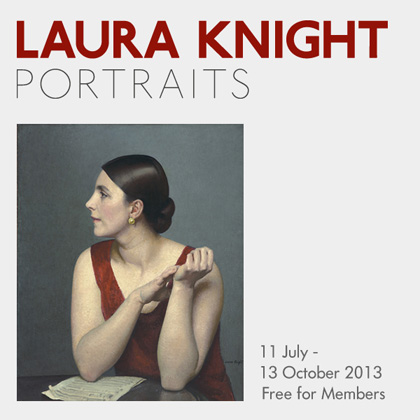Volume after volume of academic rhetoric is devoted solely to the role of women in the arts and in their history. I suspect it will continue to be such a hotly debated topic for many years to come, and I think it is unfortunate that so many artistic careers are overshadowed by the issue of gender, and that many works by female artists cannot be extricated from associations with feminism, whatever the artist’s intentions. One of the first facts that I learnt about Laura Knight was that she was the first woman to be elected to the Royal Academy. This is of course highly commendable, considering that the art establishment was so male-dominated. But for me, her pioneering status is unrelated to her gender. What I find extraordinary about her is the way that no subject was too trivial or uninteresting to her; no figure was too unimportant or too much of an outsider. She never limited herself: her works display a huge variety of subject matter, all united by one theme – portraiture. From gypsies to clowns, dancers to playwrights: each sitter was accorded the same amount of effort and significance. This exhibition did its best to display each significant part of her oeuvre, and while it was small in size, it succeeded in presenting an impressive cross-section of this wonderful artist’s extensive career.
The first work visitors were presented with was her 1913 Self Portrait. Controversial and criticised at its time of creation, this work is pioneering in the sense that it makes a bold statement about the equality of male and female artists. Women had been painting themselves in conventional poses and smart dress for a long time already, but there stands Laura Knight with her back to the viewer, wearing fairly ‘ordinary’ clothes, in the process of painting a nude model (which was completely taboo for women artists). The work seems to be a striking image of her life and ambition, reduced into one breathtaking painting. Her bold use of colour is also seen in Rose and Gold (1914). She once famously stated that “an ebullient vitality made me want to paint the whole world”, and this work is a perfect example of that sentiment. Her startling brushstrokes and bright hues create a scene full of vibrancy and joy that perfectly embodies her passion for life.
In 1919, Laura and her husband Harold moved to London, where Laura spent time backstage observing and painting Diaghilev’s Ballets Russes, and then actresses in Drury Lane and the Regent Theatre. She considered women performers to be her ‘fellow workers’ within the arts, and like Degas, she focused not on the polished grandeur of performance, but on the private intimacy of preparation and dressing rooms. This theme of performers ‘off-duty’ and behind the scenes is continued in her paintings of circus performers, such as Three Clowns (1930). By immersing herself in their daily routines, she gained a deeper understanding of their lives as travelling performers, and as a result her circus and gypsy works are full of colour and character.
Laura’s trip to Baltimore, Maryland in 1926 produced a skilled series of drawings of patients in the racially segregated wards of Johns Hopkins Memorial Hospital. The drawings are closely cropped and reveal little about the identity or character of the subject, but are very intriguing and somehow haunting. The wide-eyed child in The Piccaninny (1927) is particularly striking. The group of drawings formed a quiet corner of the colourful first room of the exhibition, and the two styles contrast well.
War presented Laura with a challenge. Employed by the War Artists Advisory Committee, her artistic autonomy (particularly her choice of subject) was suddenly limited. However, the result is overwhelmingly successful. Only about 13% of WAAC artists were female, and they were usually steered towards depicting more domestic subjects, like nursing and food centres. Take-Off (1943) is a stirring combination of vibrant colour and dramatic lighting that creates an incredibly striking work of action and intensity.
Her images of women at work promote and celebrate their position during the war, just as they were intended to. Ruby Loftus Screwing a Breech Ring has grown to be an iconic image of the British women’s war effort. It is dynamic, detailed and impressive, and perfectly fulfils the WAAC’s desire for a female factory worker role model. The Nuremberg Trial, however, is an extraordinary work that shows the darker side of the war, the side of devastation and destruction that cannot be reduced or censored, and it contrasts well with the somewhat sterilised or idealised images of factory workers.
In my opinion, Laura Knight was an extraordinary woman, and this exhibition gave me a sense of the eccentricity and adventure that was her existence. It was successful in showing that her work contains the same expressive vitality and dynamic spirit as she did as she made her inquisitive journey through life.
For more information, please visit the National Portrait Gallery’s website.









A well written and immensely interesting article. This has helped me gain an insight into Laura Knight’s life. I only wish I could have gone to the exhibition